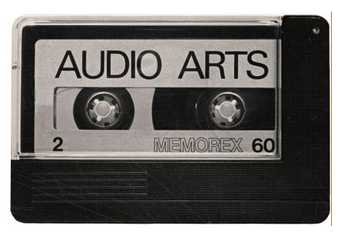It was announced today that all the issues of the seminal magazine, Audio Arts have been made available digitally, for the first time, on Tate website. This unique publication, originally distributed via cassette tape and edited by the artist William (Bill) Furlong from 1972 to 2004, comprises 245 hours of rich material featuring over 1,640 interviews with artists, critics and art world figures. It provides an invaluable resource and fascinating insight into the art world over forty years. Audio Arts is now available to the public at http://www.tate.org.uk/audio-arts.
The list of interviewees is stellar and includes some of the most important artists of the late twentieth century. It features, among others, Marina Abramovic, Carl Andre, Joseph Beuys, Daniel Buren, John Cage, Tacita Dean, Michael Craig-Martin, Tracey Emin, Gilbert & George, Richard Hamilton, Mona Hatoum, Susan Hiller, Damien Hirst, Howard Hodgkin, Anish Kapoor, Ellsworth Kelly, John Latham, Richard Long, Sarah Lucas, Chris Ofili, Gerhard Richter, Richard Serra, Nancy Spero, Sam Taylor-Wood, Mark Wallinger, Andy Warhol and Rachel Whiteread. Many artists were interviewed when they were beginning to be known, and subsequently at later dates, shedding light on the trajectory of their artistic careers and the development of their ideas and views.
Audio Arts represents one of the largest archive collections to have entered the Tate Archive. It was acquired from Bill Furlong in 2004 and comprises over 350 boxes of taped interviews on reel-to-reel tapes, cassettes and digital formats, as well as other material such as mock-ups of each issue, associated correspondence and photographs. The digitisation process, made possible through the generosity of The Rootstein Hopkins Foundation, took two years to complete, utilising a state of the art digitisation suite to develop a rich, audio environment on Tate website.
Uniquely at the time of inception Audio Arts provided a dedicated space in which artists and art world professionals spoke about their work in a free and unmediated way. It recognised the potential of the then relatively new audio cassette technology, which enabled the production of the magazine at a low cost and allowed for relatively easy international distribution. Thus the magazine created a new medium to record artistic activity and enabled it to be shared with a new audience.
Adrian Glew, Archivist, Tate said:
We are delighted to house and care for this important and large archive collection in the Tate Archive and to be able to make it available online, a huge achievement. It represents one of the most important sound archives of artists and their thoughts across four decades, and will be an invaluable tool to researchers for generations to come.
Bill Furlong said:
In some respects Audio Arts could be regarded as a commentary and insight into a period of contemporary art history as in addition to the interviews a sense of time and place is implicit in each recording.
Throughout the project, Bill and Violet Furlong provided invaluable assistance and guidance, with advice on the catalogue entries and ensuring that the audio material was preserved in such a way that each technical process was meticulously documented.

